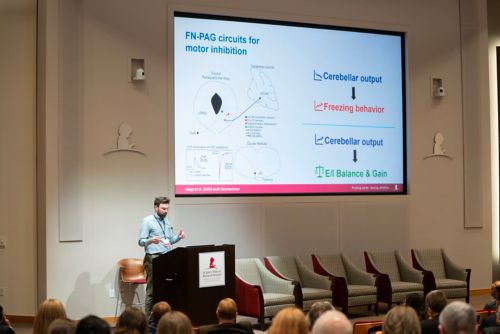St. Jude Family of Websites
Explore our cutting edge research, world-class patient care, career opportunities and more.
St. Jude Children's Research Hospital Home

- Fundraising
St. Jude Family of Websites
Explore our cutting edge research, world-class patient care, career opportunities and more.
St. Jude Children's Research Hospital Home

- Fundraising
Stuart McAfee Lab
Investigating the anatomical and neuronal basis of posterior fossa syndrome
Overview
Following tumor removal for medulloblastoma, approximately one in four children develop deficits in speech, movement and affect – a condition called posterior fossa syndrome (PFS) or cerebellar mutism syndrome. PFS is one of the most devastating survivorship outcomes for those with posterior fossa tumors, and my research focuses on understanding the etiology of PFS and developing risk assessment tools to identify those at high risk for developing this condition.
McAfee research summary
Surgical resection is a common treatment strategy for pediatric brain tumors located in the posterior fossa. However, removing these tumors can disrupt normal brain function, leading to a variety of PFS symptoms such as loss of speech, motor difficulties and behavioral issues. Onset of symptoms can occur hours or days after surgery and can resolve spontaneously in as little as a few days or persist for months. However, even after these symptoms resolve, patients with PFS face greater long-term challenges, due to more severe motor and cognitive impairments compared to non-PFS patients with similar cancer treatments.
The delayed onset and transient nature of symptoms suggest neuronal dysfunction is somehow acquired in remote areas connected to the surgical injury site. However, the intricacies of the disease process and the effect that surgery has on brain circuits are not well understood. I am interested in identifying the anatomical and neuronal changes that occur in children with PFS. This information will guide the development of predictive models that identify individuals at high-risk for developing this syndrome.
Understanding injury
Surgical removal of tumors in the cerebellum can inadvertently cause damage with neurological impact, not only from the physical removal of the tumor and damage to the surrounding margins, but also indirectly through disrupted synaptic connections. Downstream neurological effects can occur as the brain evolves to function after undergoing a surgically induced structural change.
Alongside colleagues in the Sitaram lab, we have taken a neuroscience approach to studying PFS and localized surgical injuries to specific regions in the brain. Comparative analysis of magnetic resonance images (MRI) of the cerebellum and brainstem of children with PFS versus a non-PFS medulloblastoma control group allowed us to identify regions of the brain and brain circuits related to the symptoms of PFS, which can be heterogeneous in nature. We also conducted connectivity analyses to measure how consistently co-active specific areas of the brain were, which identified PFS-related alterations in brain function.
My work has also shifted the field’s understanding of mutism in PFS as I provided support for PFS-related impact on two branches of the speech motor system: one for planning language and articulating sound and another for creating vocal sounds. Analysis of functional MRIs showed a desynchronization between these two branches in patients with PFS-related mutism, highlighting a potentially unique and undiscovered role of the cerebellum in this syndrome.

We have also found evidence that periaqueductal grey (PAG) dysfunction plays a role in transient post-operative speech disruption in patients with PFS. Analysis of imaging data gathered before and after speech recovery allowed us to pinpoint the functional consequences of PAG dysfunction and, furthermore, to see the restoration of functional connectivity of the PAG once patients regained the ability to speak. These results helped us to understand the role of PAG in speech impairment and potentially identify novel pathways involved in speech recovery.
Education and intervention
As we look for ways to improve quality of life for pediatric cancer survivors, understanding PFS and how to ameliorate the risk is of the utmost importance. Due to the rarity of pediatric tumors in the posterior fossa, many care teams who come across these tumors are not well versed in the existence or treatment of PFS. I work with the Posterior Fossa Society to educate healthcare providers about the existence and impact of PFS on patients.
I am also developing a risk-assessment tool that would use data from preoperative MRIs to generate a risk score for PFS. Preemptively identifying those at high-risk of developing PFS will provide valuable information to surgeons as they would be able to tailor their surgical treatment strategy to decrease the risk for PFS.
Publications
About Stuart McAfee
Dr. McAfee is a neuroscientist who received his PhD in neuroscience from the University of Tennessee Health Science Center in Memphis, TN. In 2018 he joined St. Jude as a postdoctoral research assistant in the Department of Radiology, focusing on functional neuroimaging. Dr. McAfee transitioned to a medical imaging scientist before becoming an Instructor in the Department of Radiology. His research uses neuroimaging and advanced analytic tools to improve cognitive outcomes and quality of life for pediatric cancer survivors, specifically children with posterior fossa syndrome.
Affiliations

Contact us
Stuart McAfee, PhD
Instructor, St. Jude Faculty
Department of Radiology
MS 220, I3116
St. Jude Children’s Research Hospital

Memphis, TN, 38105-3678 USA GET DIRECTIONS